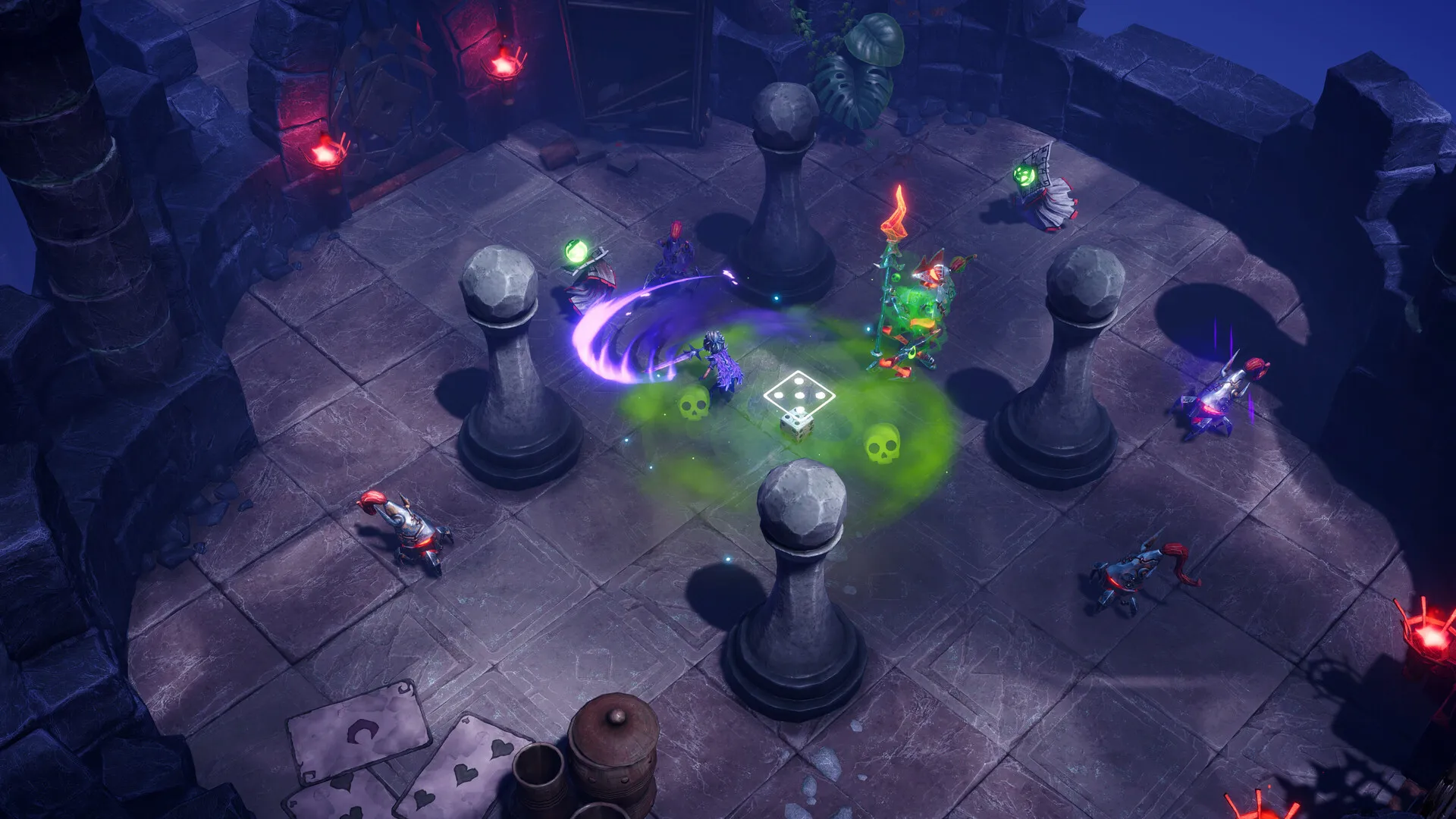Lost in Random: The Eternal Die emerges not as a direct continuation of its predecessor’s narrative-adventure format, but as a bold pivot into the demanding world of the action roguelike. The game casts players in the unlikely role of Queen Aleksandra, the antagonist of the first entry.
Her new predicament finds her trapped within the confines of the Black Die, a cursed artifact whose internal landscapes are both perilous and in constant flux. To navigate these hostile realms, she is accompanied by Fortune, a small, sentient die that acts as her companion and weapon.
The game immediately establishes its visual signature: a gothic storybook aesthetic that feels handcrafted and beautifully eerie. This dark-fantasy world, filled with spindly characters and puppet-like creations, sets a distinct and memorable tone from the opening moments, promising a journey through a world governed by chance and whimsy.
The Art of Combat
The game’s action unfolds from a top-down isometric perspective, a camera angle well-suited for the genre. This viewpoint offers a clear and comprehensive look at the battlefield, allowing for precise management of enemy hordes and incoming threats. Combat is built upon a foundation of three interconnected systems that players must master.
At its most direct is the weaponry, with a choice of a sword, spear, bow, or hammer available before each run. Each armament possesses a distinct rhythm and weight, complete with standard and charged attacks that dictate the flow of engagement. Supporting this is Aleksandra’s companion, Fortune, who can be thrown to deal area-of-effect damage.
The amount of damage is tied to the number rolled, injecting a welcome element of risk into every toss. The final piece is the Card system. By landing attacks, players accumulate energy to activate powerful, single-use abilities that can turn the tide, from launching fireballs to creating fields of electricity.
This design produces a quick, responsive, and satisfying combat experience. The enemies, ranging from disposable fodder to elite foes with coordinated attack patterns, ensure that every encounter remains a tense and engaging test of skill.
The Cycle of Growth and Randomness
The game’s structure is defined by the roguelike loop of fighting, failing, and growing stronger. Each death returns Aleksandra to a central hub world, the Sanctuary, where the fruits of her previous attempt can be invested in permanent upgrades.
Two forms of currency drive this progression. “Cinder” is spent at a forge to enhance the four weapon types, unlocking specialized build paths. “Pip Dust” is exchanged for Blessings, which are lasting improvements to Aleksandra’s health, damage, and other core stats.
The game is notably generous with these rewards, ensuring that even a short, unsuccessful run yields enough resources to feel productive. Progression within a single attempt is equally well-realized. The dungeon is presented as a board game map, offering choices that lead to rooms with different encounters, from combat arenas to shops. The “Relic” system is the heart of this in-run development.
These passive buffs are collected throughout a run and form the basis of a build, synergizing with weapon choices and Card abilities. The Relics are color-coded, and matching sets on the inventory board provides substantial stat boosts, adding a satisfying layer of strategic collection to each attempt.
A Tale Half-Told
The game’s presentation is a high point. Its strong artistic direction successfully translates the gothic storybook style into the new format, and the four biomes—a castle, a swamp, and a steampunk ice world among them—offer excellent visual variety.
The quality extends to the technical execution, with a cast of quirky characters brought to life by strong voice acting and a soundtrack that knows precisely when to swell to heighten the action. The narrative, however, does not reach these same heights. The story follows Queen Aleksandra on a path to redemption, but its delivery is flawed.
The plot is introduced with an abruptness that provides little context for her motivations or the stakes of her journey. This issue is especially noticeable for players who have not experienced the first game, leaving them without a strong emotional anchor to the protagonist.
While the individual characters are charming, the central plot feels underdeveloped. The primary drive to continue playing comes from the excellent gameplay loop, not from a desire to see the story reach its resolution.
The Review
Lost in Random: The Eternal Die
Lost in Random: The Eternal Die is a mechanically excellent action roguelike that succeeds on the strength of its fast-paced combat and deeply rewarding progression systems. Its beautiful, gothic art style creates a memorable world that is a pleasure to fight through again and again. While the core gameplay loop is addictive and polished, the game is held back by an underdeveloped narrative that fails to provide a compelling emotional anchor, particularly for those unfamiliar with the original. It's a fantastic game to play, but a less effective one to experience.
PROS
- Satisfying, responsive, and tactical combat.
- A rewarding progression loop that makes every run feel meaningful.
- Stunning and unique gothic storybook art style.
- High replayability with varied builds and randomized elements.
CONS
- An underdeveloped story that lacks emotional weight.
- The narrative can be confusing for players new to the series.
- The gameplay, while polished, does not significantly innovate on the genre.

















































